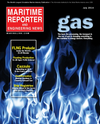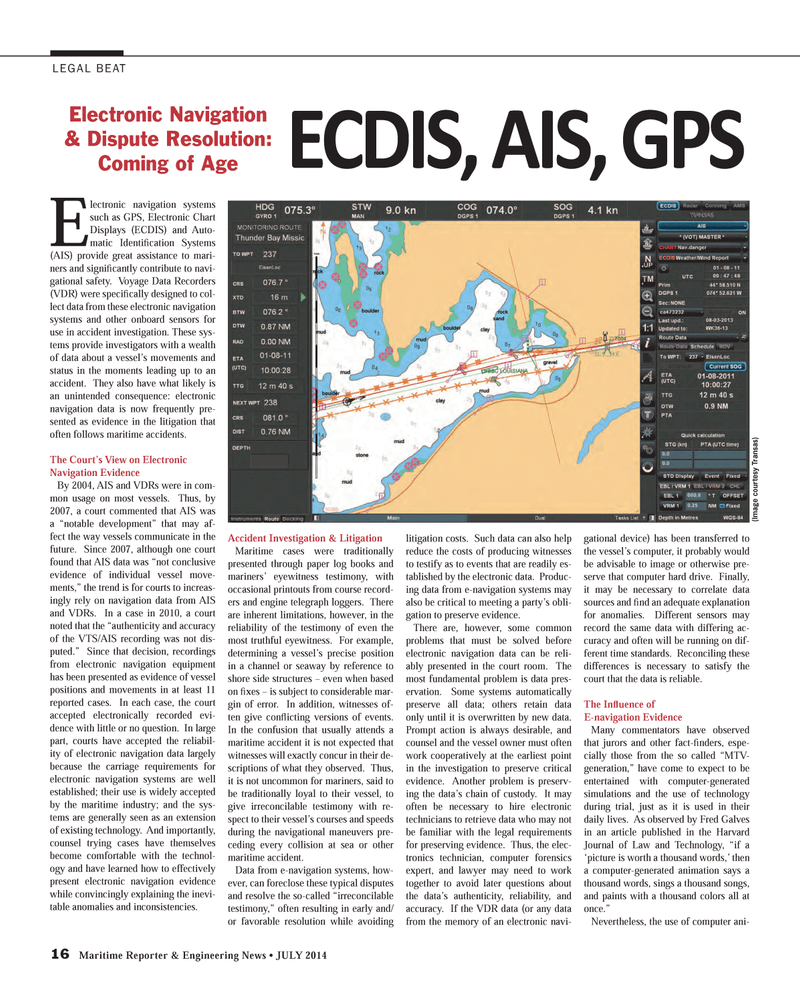
Page 16: of Maritime Reporter Magazine (July 2014)
Offshore Energy Structures & Systems
Read this page in Pdf, Flash or Html5 edition of July 2014 Maritime Reporter Magazine
16 Maritime Reporter & Engineering News • JULY 2014
LEGAL BEAT
E lectronic navigation systems such as GPS, Electronic Chart
Displays (ECDIS) and Auto- matic Identifi cation Systems (AIS) provide great assistance to mari- ners and signifi cantly contribute to navi- gational safety. Voyage Data Recorders (VDR) were specifi cally designed to col- lect data from these electronic navigation systems and other onboard sensors for use in accident investigation. These sys- tems provide investigators with a wealth of data about a vessel’s movements and status in the moments leading up to an accident. They also have what likely is an unintended consequence: electronic navigation data is now frequently pre- sented as evidence in the litigation that often follows maritime accidents.
The Court’s View on Electronic
Navigation Evidence
By 2004, AIS and VDRs were in com- mon usage on most vessels. Thus, by 2007, a court commented that AIS was a “notable development” that may af- fect the way vessels communicate in the future. Since 2007, although one court found that AIS data was “not conclusive evidence of individual vessel move- ments,” the trend is for courts to increas- ingly rely on navigation data from AIS and VDRs. In a case in 2010, a court noted that the “authenticity and accuracy of the VTS/AIS recording was not dis- puted.” Since that decision, recordings from electronic navigation equipment has been presented as evidence of vessel positions and movements in at least 11 reported cases. In each case, the court accepted electronically recorded evi- dence with little or no question. In large part, courts have accepted the reliabil- ity of electronic navigation data largely because the carriage requirements for electronic navigation systems are well established; their use is widely accepted by the maritime industry; and the sys- tems are generally seen as an extension of existing technology. And importantly, counsel trying cases have themselves become comfortable with the technol- ogy and have learned how to effectively present electronic navigation evidence while convincingly explaining the inevi- table anomalies and inconsistencies.
Accident Investigation & Litigation
Maritime cases were traditionally presented through paper log books and mariners’ eyewitness testimony, with occasional printouts from course record- ers and engine telegraph loggers. There are inherent limitations, however, in the reliability of the testimony of even the most truthful eyewitness. For example, determining a vessel’s precise position in a channel or seaway by reference to shore side structures – even when based on fi xes – is subject to considerable mar- gin of error. In addition, witnesses of- ten give confl icting versions of events.
In the confusion that usually attends a maritime accident it is not expected that witnesses will exactly concur in their de- scriptions of what they observed. Thus, it is not uncommon for mariners, said to be traditionally loyal to their vessel, to give irreconcilable testimony with re- spect to their vessel’s courses and speeds during the navigational maneuvers pre- ceding every collision at sea or other maritime accident.
Data from e-navigation systems, how- ever, can foreclose these typical disputes and resolve the so-called “irreconcilable testimony,” often resulting in early and/ or favorable resolution while avoiding litigation costs. Such data can also help reduce the costs of producing witnesses to testify as to events that are readily es- tablished by the electronic data. Produc- ing data from e-navigation systems may also be critical to meeting a party’s obli- gation to preserve evidence.
There are, however, some common problems that must be solved before electronic navigation data can be reli- ably presented in the court room. The most fundamental problem is data pres- ervation. Some systems automatically preserve all data; others retain data only until it is overwritten by new data.
Prompt action is always desirable, and counsel and the vessel owner must often work cooperatively at the earliest point in the investigation to preserve critical evidence. Another problem is preserv- ing the data’s chain of custody. It may often be necessary to hire electronic technicians to retrieve data who may not be familiar with the legal requirements for preserving evidence. Thus, the elec- tronics technician, computer forensics expert, and lawyer may need to work together to avoid later questions about the data’s authenticity, reliability, and accuracy. If the VDR data (or any data from the memory of an electronic navi- gational device) has been transferred to the vessel’s computer, it probably would be advisable to image or otherwise pre- serve that computer hard drive. Finally, it may be necessary to correlate data sources and fi nd an adequate explanation for anomalies. Different sensors may record the same data with differing ac- curacy and often will be running on dif- ferent time standards. Reconciling these differences is necessary to satisfy the court that the data is reliable.
The Infl uence of
E-navigation Evidence
Many commentators have observed that jurors and other fact-fi nders, espe- cially those from the so called “MTV- generation,” have come to expect to be entertained with computer-generated simulations and the use of technology during trial, just as it is used in their daily lives. As observed by Fred Galves in an article published in the Harvard
Journal of Law and Technology, “if a ‘picture is worth a thousand words,’ then a computer-generated animation says a thousand words, sings a thousand songs, and paints with a thousand colors all at once.”
Nevertheless, the use of computer ani- (Image cour tesy T ransas)
ECDIS, AIS, GPS
Electronic Navigation & Dispute Resolution:
Coming of Age
MR #7 (10-17).indd 16 6/30/2014 10:30:41 AM

 15
15

 17
17
